
The Avro Type 694 Lincoln is a British four-engined heavy bomber, which first flew on 9 June 1944. Developed from the Avro Lancaster, the first Lincoln variants were initially known as the Lancaster IV and V; these were renamed Lincoln I and II. It was the 2nd last piston-engined bomber operated by the Royal Air Force (RAF).
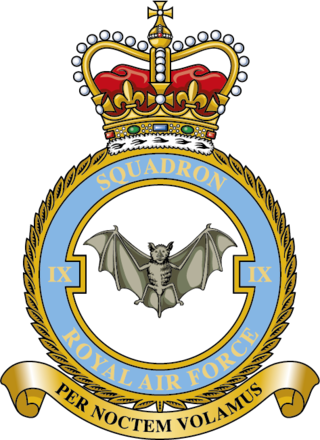
Number 9 Squadron is the oldest dedicated Bomber Squadron of the Royal Air Force. Formed in December 1914, it saw service throughout the First World War, including at the Somme and Passchendaele. During the Second World War, No. IX (B) Squadron was one of two Avro Lancaster units specialising in heavy precision bombing and sank the battleship Tirpitz on 12 November 1944 in Operation Catechism. Between 1962 and April 1982, the squadron flew the Avro Vulcan B.2 as part of the V-Force. In June 1982, it became the first front-line squadron in the world to operate the Panavia Tornado GR.1. In May 1998, No. IX (B) Squadron received the RAF's first Tornado GR.4, which it operated until reequipping with the Eurofighter Typhoon FGR.4 at its present home base of RAF Lossiemouth on 1 April 2019.

No. 7 Squadron is a special operations support squadron of the Royal Air Force operates the Boeing Chinook HC6 from RAF Odiham, Hampshire.

Number 12 Squadron, also known as No. 12 (Bomber) Squadron and occasionally as No. XII Squadron, is a flying squadron of the Royal Air Force (RAF). The squadron reformed in July 2018 as a joint RAF/Qatar Emiri Air Force squadron. It is currently based at RAF Coningsby, Lincolnshire, and operates the Eurofighter Typhoon FGR4, while temporarily integrating Qatari air and ground crews in order to provide training and support as part of the Qatari purchase of 24 Typhoons from the UK.

No. 220 Squadron of the Royal Air Force (RAF) was founded in 1918 and disbanded in 1963 after four separate periods of service. The squadron saw service in both the First and Second World Wars, as a maritime patrol unit, and finally as part of Britain's strategic nuclear deterrent.

No. 1 Group of the Royal Air Force is one of the two operations groups in RAF Air Command. Today, the group is referred to as the Air Combat Group, as it controls the RAF's combat fast-jet aircraft and has airfields in the UK, as well as RAF Support Unit Goose Bay at CFB Goose Bay in Canada. The group headquarters is located alongside Headquarters Air Command at RAF High Wycombe, Buckinghamshire. The other operational group is No. 2 Group RAF.
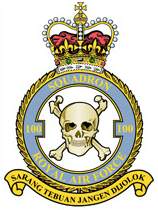
Number 100 Squadron is a former Royal Air Force squadron. It last operated the British Aerospace Hawk T1, providing 'aggressor' aircraft for air combat training from RAF Leeming in North Yorkshire, UK.
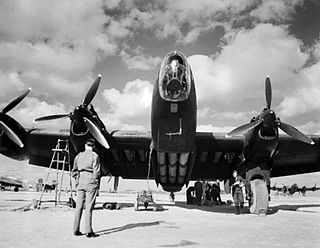
No. 148 Squadron was a squadron of the Royal Air Force disbanded and re-established several times since the First World War, until its dissolution on 1 May 1965. During the Second World War, the squadron operated as a Special Duties squadron performing partisan supply missions and working closely with the Special Operations Executive for agent drop and pick-up operations.
Tiger Force, also known as the Very Long Range Bomber Force, was the name given to a World War II British Commonwealth long-range heavy bomber force, formed in 1945, from squadrons serving with RAF Bomber Command in Europe, for proposed use against targets in Japan. The unit was scheduled to be deployed to Okinawa in the Pacific theatre in the lead-up to the Allies' proposed invasion of Japan. The unit was disbanded after the bombings of Hiroshima and Nagasaki and the Soviet invasion of Manchuria ended the war.

No. 35 Squadron was a squadron of the Royal Air Force.
No. 189 Squadron was a Royal Air Force squadron.
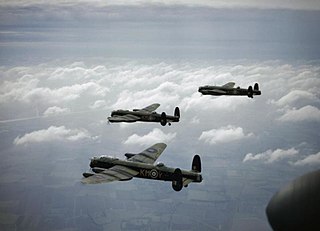
Number 44 (Rhodesia) Squadron was an aviation unit of the Royal Air Force. It was active between 1917 and 1982. For most of its history it served as a heavy bomber squadron.

No. 463 Squadron RAAF was a Royal Australian Air Force heavy bomber squadron during World War II. The squadron was formed in the United Kingdom in late 1943 from personnel and aircraft allocated from No. 467 Squadron RAAF. The squadron was equipped with Avro Lancaster bombers and flew its first raids on Germany immediately after being formed. Operating as part of RAF Bomber Command No. 463 Squadron conducted raids against cities, industrial facilities and military targets in Germany, France and Norway throughout 1944 and until the end of the war in May 1945. Following the war, the squadron evacuated Allied prisoners of war from Europe until it was disbanded in late 1945.

No. 467 Squadron RAAF was a Royal Australian Air Force bomber squadron, active over North West Europe during World War II. Formed in November 1942 as an Article XV Squadron in Britain, the squadron was notionally an Australian squadron under the command of the Royal Air Force, and consisted of a mixture of personnel from various Commonwealth nations. After becoming operational in early 1943, the squadron flew operations in Occupied Europe until the end of the war flying Avro Lancaster heavy bombers. It was scheduled to deploy to the Far East to take part in further operations against Japan, but the war ended before it could complete its training and the squadron was disbanded in September 1945.
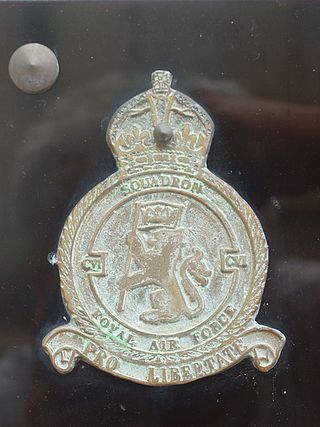
No. 106 Squadron RAF was a Royal Flying Corps and Royal Air Force squadron active from 1917 until 1919, throughout World War II and during the Cold War from 1959 until 1963.
No. 198 Squadron was a Royal Air Force aircraft squadron that operated during the Second World War particularly in the ground attack role as the allies advanced through continental Europe.

No. 166 Squadron RAF was a Royal Air Force squadron that formed just before the end of World War I. It was the first and one of only three to be equipped with the Handley Page V/1500 heavy bomber.
No. 170 Squadron RAF was a Second World War Royal Air Force squadron that operated the North American Mustang in the fighter-reconnaissance role and later the Avro Lancaster as part of Bomber Command.

440 Transport Squadron is a unit of the Canadian Armed Forces under the Royal Canadian Air Force. It is part of 8 Wing and works closely with Joint Task Force (North) in Yellowknife, Northwest Territories.














